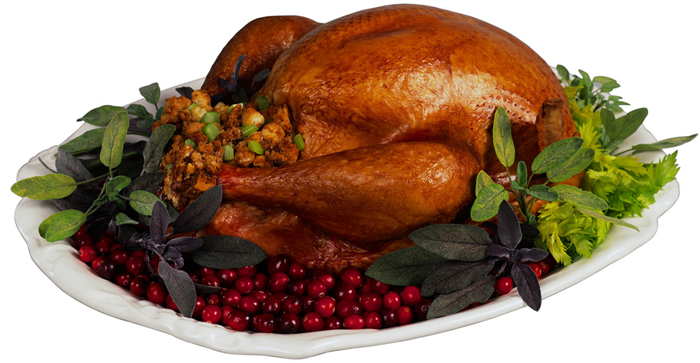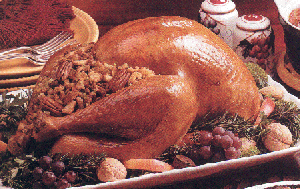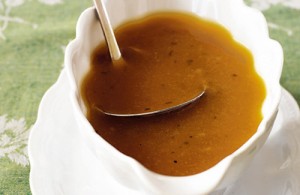
- Cooking Turkey (2 Recipes)
- Making Stuffing (3 Recipes)
- Making Gravy (3 Recipes)
Cooking Turkey
(1) Basic Turkey Cooking
Preheat oven to 350° F. Remove the neck, liver, and other body parts from the turkey. Rinse the turkey inside and out twice with cold water and pat dry with paper towels.
Place on several sheets of aluminum foil to season. Discard the paper towels and wash the area you were just working in with disinfectant soap to prevent cross-contamination of the work area.
Bush the turkey with oil, margarine or melted butter and season with salt, pepper or your favorite seasonings inside and out. Cut off the tips of the wings and save for a stock. Truss the turkey (tie with string) or use the plastic or metal clamps supplied with the turkey. Place the turkey breast side down on a wire rack in a shallow, uncovered roasting pan. Discard the aluminum foil you seasoned it on and once again wash the area you were just working in with disinfectant soap to prevent cross-contamination of the work surface.
Roast back-side-up for 1 ½ hours, remove from the oven. Turn over and add 2 each thinly sliced onions, stalks of celery, carrots and cloves of garlic to the pan. Cover loosely with foil and baste every 45 minutes with the pan juices. Remove the foil during the last 45 minutes of cooking and baste one more time. To check for doneness: internal temperature should reach 170-175° F. when a thermometer is inserted in to the turkey’s thigh at the thickest part, or the turkey’s timer should pop up. Remove the turkey and let stand 20 minutes before carving.
Oven temperatures vary greatly from oven to oven so it is highly recommended to buy a good quality oven thermometer to check you oven and become familiar with how to adjust the oven’s dial to correspond with the desired temperature. You may also call a service technician from your stove’s manufacturing service center to calibrate the oven’s controls.
Good Cooking’s Turkey Roasting Time Table
Weight in pounds / Cooking time in hours (Unstuffed)
10-12……….2 ¾ – 3 hours
12-14………..3 ¾ – 4 ¼ hours
14-18…………4 – ¼ hours
18-20…………4 ¼ – 4 ½ hours
20-24…………4 ½ – 5 hours
(2) Turkey Basics, Safe Cooking from USDA
A food thermometer should be used to ensure a safe minimum internal temperature of 165 °F has been reached to destroy bacteria and prevent foodborne illness.
Many variables can affect the roasting time of a whole turkey:
- A partially frozen turkey requires longer cooking.
- A stuffed turkey takes longer to cook.
- The oven may heat food unevenly.
- Temperature of the oven may be inaccurate.
- Dark roasting pans cook faster than shiny metals.
- The depth and size of the pan can reduce heat circulation to all areas of the turkey.
- The use of a foil tent for the entire time can slow cooking.
- Use of the roasting pan’s lid speeds cooking.
- An oven cooking bag can accelerate cooking time.
- The rack position can have an affect on even cooking and heat circulation.
- A turkey or its pan may be too large for the oven, thus blocking heat circulation.
ROASTING INSTRUCTIONS
- Set the oven temperature no lower than 325 °F. Preheating is not necessary.
- Be sure the turkey is completely thawed. Times are based on fresh or thawed birds at a refrigerator temperature of 40 °F or below.
- Place turkey breast-side up on a flat wire rack in a shallow roasting pan 2 to 2 1/2 inches deep.Optional steps:
– Tuck wing tips back under shoulders of bird (called “akimbo”).
– Add one-half cup water to the bottom of the pan.
– In the beginning, a tent of aluminum foil may be placed loosely over the breast of the turkey for the first 1 to 1 1/2 hours, then removed for browning. Or, a tent of foil may be placed over the turkey after the turkey has reached the desired golden brown color. - For optimum safety, cook stuffing in a casserole. If stuffing your turkey, mix ingredients just before stuffing it; stuff loosely. Additional time is required for the turkey and stuffing to reach a safe minimum internal temperature (see chart).
- For safety and doneness, the internal temperature should be checked with a food thermometer. The temperature of the turkey and the center of the stuffing must reach a safe minimum internal temperature of 165 °F. Check the temperature in the innermost part of the thigh and wing and the thickest part of the breast.
- Let the bird stand 20 minutes before removing stuffing and carving.
APPROXIMATE COOKING TIMES
(325 °F oven temperature)
UNSTUFFED (time in hours)
4 to 6 lb. breast …… 1 1/2 to 2 1/4
6 to 8 lb. breast …… 2 1/4 to 3 1/4
8 to 12 lbs. …….…… 2 3/4 to 3
12 to 14 lbs. …….…… 3 to 3 3/4
14 to 18 lbs. …….…… 3 3/4 to 4 1/4
18 to 20 lbs. ….……… 4 1/4 to 4 1/2
20 to 24 lbs. ….……… 4 1/2 to 5
STUFFED (time in hours)
8 to 12 lbs. …..…. 3 to 3 1/2
12 to 14 lbs. …..… 3 1/2 to 4
14 to 18 lbs. …..… 4 to 4 1/4
18 to 20 lbs. …..… 4 1/4 to 4 3/4
20 to 24 lbs. …..… 4 3/4 to 5 1/4
Making Stuffing (3 Recipes)
 (1) Thanksgiving Stuffing
(1) Thanksgiving Stuffing
Ready In: 30 Min, Original Recipe Yield 12 servings
Ingredients
- 1 1/2 pounds ground sage pork sausage
- 4 onions, chopped
- 2 stalks celery, chopped
- 6 cups crumbled cornbread
- 6 cups cubed soft white bread
- 1 cup chicken broth
- 2 eggs, lightly beaten
- 2 teaspoons poultry seasoning
- 1 teaspoon steak sauce
- 1 tablespoon salt
Directions
- Place the sausage in a skillet over medium heat. Cook, breaking sausage apart with a fork, until evenly brown. Set aside, reserving pan drippings.
- Mix onions and celery into skillet, and cook in the pan drippings until browned. Drain remaining drippings.
- In a large bowl, toss together the sausage, onions and celery, cornbread, white bread, broth, and eggs. Mix in poultry seasoning, steak sauce, and salt. Stuff turkey just before roasting.
(2) Southern Italian Thanksgiving Stuffing
“This is the best Thanksgiving stuffing I have ever had. With a mix of Southern-style cooking and Italian flavors it brings all great tastes together. I got this recipe from my mom last year after everyone gave it amazing reviews Recipe By Briana. Original Recipe Yield 12 servings
Ingredients
- 1 1/2 pounds bulk Italian sausage
- 2 tablespoons olive oil
- 6 ounces pancetta bacon, diced
- 2 onions, chopped
- 7 large stalks celery, chopped
- 4 cloves garlic, minced
- 6 cups day-old French bread, cut into 1/2 inch cubes
- 3 cups crumbled cornbread
- 1 1/2 tablespoons rubbed dried sage
- 1 1/2 tablespoons poultry seasoning
- 1 teaspoon salt
- 1 cup toasted pine nuts
- 4 cups chicken broth
- 2 cups shredded mozzarella cheese
- 1/2 cup butter
- 2 tablespoons chopped fresh sage
- 1 ounce shaved Parmesan cheese
Directions
- Preheat an oven to 375 degrees F (190 degrees C). Grease a deep 9×13 inch baking dish or roasting pan.
- Heat a large skillet over medium-high heat and stir in the sausage. Cook and stir until the sausage is crumbly, evenly browned, and no longer pink. Drain and discard any excess grease. Place the browned sausage into a large mixing bowl.
- Meanwhile, heat the olive oil and pancetta in a large skillet over medium heat. Once the pancetta begins to brown, stir in the onions and celery, and cook until the onion softens and turns translucent, about 8 minutes. Stir in the garlic, and cook another 3 minutes until the aroma of the garlic mellows.
- Scrape the onion mixture into the bowl with the crumbled sausage. Add the French bread, cornbread, dried sage, poultry seasoning, salt, and pine nuts; stir well. Pour in the chicken broth and mozzarella cheese; stir until the chicken stock has been absorbed by the bread and the stuffing is evenly mixed. Pack the stuffing into the prepared baking dish, and dot the butter overtop. Cover with aluminum foil.
- Bake in the preheated oven for 45 minutes, then remove the foil, and continue baking until the top has turned golden brown, about 15 minutes more. Sprinkle with the fresh sage and shaved Parmesan cheese to serve.
(3) Stuffing from Butterball
Add taste to your Butterball Stuffing. Here are some popular additions: chopped and sautéed onion and/or celery, chopped nuts, green chilies, sliced mushrooms, sliced water chestnuts. Substitute Butterball Chicken Broth for water in your stuffing for added flavor! Add fruit to personalize your Butterball stuffing. Here are some of our favorites: chopped fresh cranberries, chopped apples, raisins, chopped dried fruit.
Use Butterball Stuffing instead of breadcrumbs for better tasting meatloaf, hamburgers, coated chicken or stuffed pork chops. Butterball Stuffing is great for stuffing vegetables! Add cooked and drained sausage or oysters to Butterball Stuffing for extra savory flavor. No croutons? No problem when you have Butterball Seasoned Stuffing. Just sprinkle the stuffing over your favorite soup or salad and everyone will love it! Broth
To cut out fat you can make mashed potatoes with Butterball Chicken Broth vs. butter or heavy cream. Add extra flavor without extra calories to steamed vegetables simply by using Butterball Chicken Broth for water. Taste the difference! Gravy
Next time you make Butterball Gravy, use half the water and replace the other half with wine for a richer, robust flavor. Make gravy just before serving to avoid re-heating and scorching. When making Butterball Turkey or Chicken Gravy, substitute the water with Butterball Chicken Broth. Make great hot dipped sandwiches with Butterball Gravy. Heat Butterball Deli Sliced Turkey or Beef with prepared Butterball Turkey or Brown Gravy. Generously stuff a hoagie bun with the juicy meat mixture and add your favorite toppings. The family will love it! Next time you make baked potatoes top it with Butterball Gravy. It’s fast, simple and has fewer calories than butter and sour cream!
Making Gravy (3 Recipes)
 (1) Basic Turkey Gravy
(1) Basic Turkey Gravy
Two factors help make good deep-brown gravy: the drippings on the bottom of the roasting pan and the slow browning of the flour in the fat. Recipe by: Chef John Vyhnanek
Yield: about 2 cups. Preparation time: about 30 minutes
Ingredient
4 tablespoons fat from poultry
4 tablespoons flour pan drippings, including the mirepoix that was used when roasting the turkey
2 cups (1/2 litre) hot turkey or chicken stock
2 teaspoons kosher salt or to taste
½ teaspoon white pepper, ground or to taste
Preparation:
When the bird has been removed from the roasting pan, skim off all but 4 tablespoons of fat in the pan. If there is not enough fat in the drippings, add butter. Place the pan over a burner and heat it, scraping the bottom of the pan to loosen all the browned bits. (If the roasting pan is hard to handle, scrape and pour the drippings into a saucepan.) Stir in the flour and blend well over medium heat for 4 minutes or more, until lightly browned. Slowly pour in the hot stock , stirring constantly, until smooth. Simmer for 10 minutes to develop the flavor. Adjust the seasoning with salt and white pepper. You may strain the gravy at this time or use it as is.
(2) Turkey Tips: Making Perfect Gravy
Want to know how to make turkey gravy? Preparing a smooth and savory gravy is easier than you may think.
The trick to avoiding lumps is to cook together equal parts of flour with a fat, such as clarified butter, vegetable oil or grease. This mixture is known as a roux and serves as a thickener for gravy. As a general rule of thumb, a ½ cup of roux will thicken 4 cups of gravy. (See Making Roux for more information.)
Any type of liquid can be added to a roux to make gravy, including the broth or drippings from beef, pork or chicken. If you’re roasting a turkey, use the drippings from the roasting pan and turkey broth to make the gravy.
To make your own turkey broth, simmer the neck, giblets and gizzards–omitting the liver–for 1 hour in a quart of water. (The liver can impart a bitter taste.) You may add aromatics such as a bay leaf, peppercorns, quartered unpeeled onion, coarsely chopped carrot and celery and parsley stems. Strain broth and skim off fat. Turkey broth can be prepared in advance and stored in the refrigerator for up to three days. Tips By: Allrecipes.com
(3) Easy Turkey Gravy
The cream of chicken soup is what gives it wonderful flavor. Nice and creamy, never lumpy. Original Recipe Yield 7 cups
Ingredients
- 5 cups turkey stock with pan drippings
- 1 (10.75 ounce) can condensed cream of chicken soup
- 1 teaspoon poultry seasoning
- 1/2 teaspoon black pepper
- 1 teaspoon seasoned salt
- 1/4 teaspoon garlic powder
- 1 cup milk
- 1/3 cup all-purpose flour
Directions
- Bring the turkey stock to a boil in a large saucepan. Stir in soup, and season with poultry seasoning, pepper, seasoned salt, and garlic powder. Reduce heat to low, and let simmer.
- Warm the milk in the microwave, and whisk in the flour with a fork until there are no lumps. Return the gravy to a boil, and gradually stir in the milk mixture. Continue to cook, stirring constantly, for 1 minute, or until thickened. Be careful not to let the bottom scorch.
###
